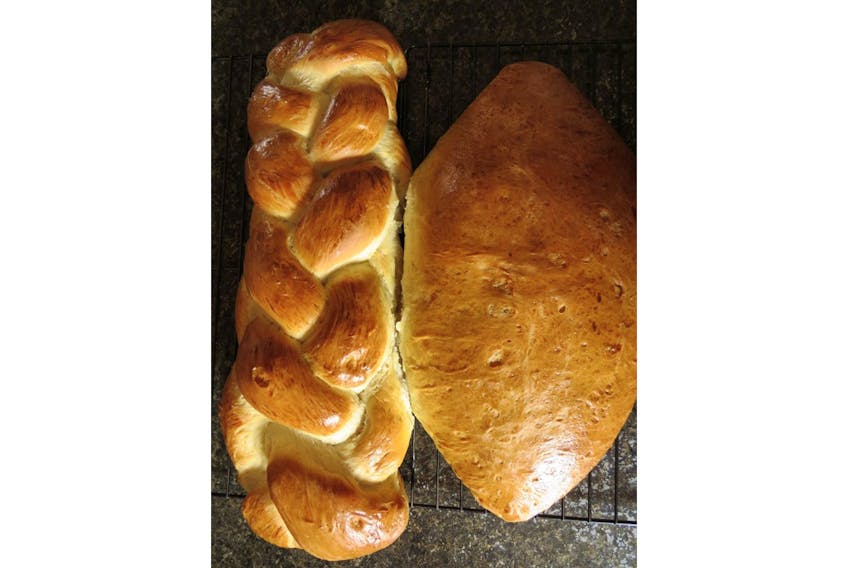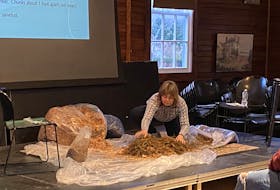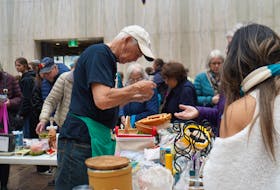During the days of the Austro-Hungarian Empire, Viennese bakers made bread using the finest flour from Hungary and developed methods for producing baker’s yeast.
Their bread was legendary, and the recipe was shared widely.
Loaves of Vienna bread have a golden, shiny crust and a fine texture. Some recipes, including the one with this column, have the bread shaped into oval loaves or braids, while others suggest crescents or split loaves. I opted for one oval loaf and one braid; see picture on Facebook.com/IslandGusto. My oval loaf is a bit funny-looking, with pointed ends, but I am happy with the four-strand braid.
To make the braid, I followed instructions from Janice Murray Gill’s Canadian Bread Book, a source I often turn to for help with bread-making.
Here’s how Gill does it.
Divide the dough into four equal portions, weighing to make sure. Roll each piece out by hand to make a rope about 50 cm (18 inches) long, tapering the ends. Place the ropes on a greased baking sheet and pinch the top ends together. The ropes will occupy positions 1, 2, 3 and 4, starting from the left.
Move the strand in position 1, far left, to position 4, far right. Move the strand in position 3 to position 1, far left. Move the strand in position 4, far right, to position 3. Move the strand in position 2 to position 4, far right. Move the strand in position 1, far left, to position 2. Move the strand in position 3 to position 1, far left.
Move the strand in position 4, far right, to position 3. Move the strand in position 2 to position 4, far right. Move the strand in position 1, far left, to position 2. Move the strand in position 3 to position 1, far left.
Repeat the last 4 steps until all the ropes have been braided. Do not stretch ropes while braiding but keep them together snugly. Tuck in the ends to make a neat finish.
Vienna Bread
Adapted from Thomas, Anna: The Vegetarian Epicure, Book Two, Alfred A. Knopf, New York, 1979.
- 2 pkg (30 mL/2 tbsp) dry yeast
- 250 mL (1 cup) lukewarm water
- 30 mL (2 tbsp) sugar, divided
- 1.3-1.5 L (5½-6½ cups) white flour
- 250 mL (1 cup) milk, scalded
- 15 mL (1 tbsp) salt
- 45 mL (3 tbsp) butter
- Glaze
- 1 egg yolk
- 15 mL (1 tbsp) milk
Dissolve the yeast in the lukewarm water and stir in 15 mL (1 tbsp) of the sugar and 375-500 mL (1½-2 cups) of the flour, enough to make a soft, spongy dough. Cover the bowl with a towel and put the sponge aside in a warm place to rise for about 45 minutes, or until it is puffed and soft.
Stir the remaining sugar, salt and butter into the hot milk, and cool to lukewarm. Add the milk mixture to sponge and stir the sponge down well. Work in as much of the remaining flour as is needed to make a fairly stiff dough. Turn the dough out onto a heavily floured board, sprinkle a little more flour over it, and knead for 10 to 15 minutes, or until it is smooth and elastic; add flour as needed to keep the dough from sticking.
Shape the dough into a ball and put it in a large, buttered bowl, turning it over once so that it is coated with butter on all sides. Cover the bowl with a light damp towel and put it in a warm, draft-free place for about 45 minutes to 1 hour, or until the dough has doubled in size.
Punch down the dough and form it into 2 oblong loaves or large braids. Put the loaves on buttered baking sheets, cover with a light damp towel, and leave in a warm place to rise for about ½ hour, or until they have nearly doubled in size.
Beat together the egg yolk and the tablespoon of milk and brush the loaves delicately with the glaze. Put them in a preheated 220 C (425 F) oven, and after 5 minutes lower the heat to 190 F (375 F). Bake the loaves for 35 to 40 minutes more, until golden brown.
Cool the loaves on racks before slicing.
Makes 2 medium-sized loaves.
Margaret Prouse, a home economist, writes this column for The Guardian every Friday.









